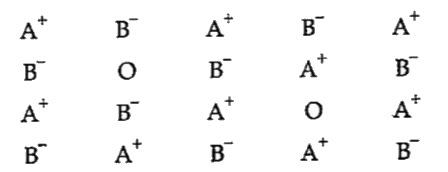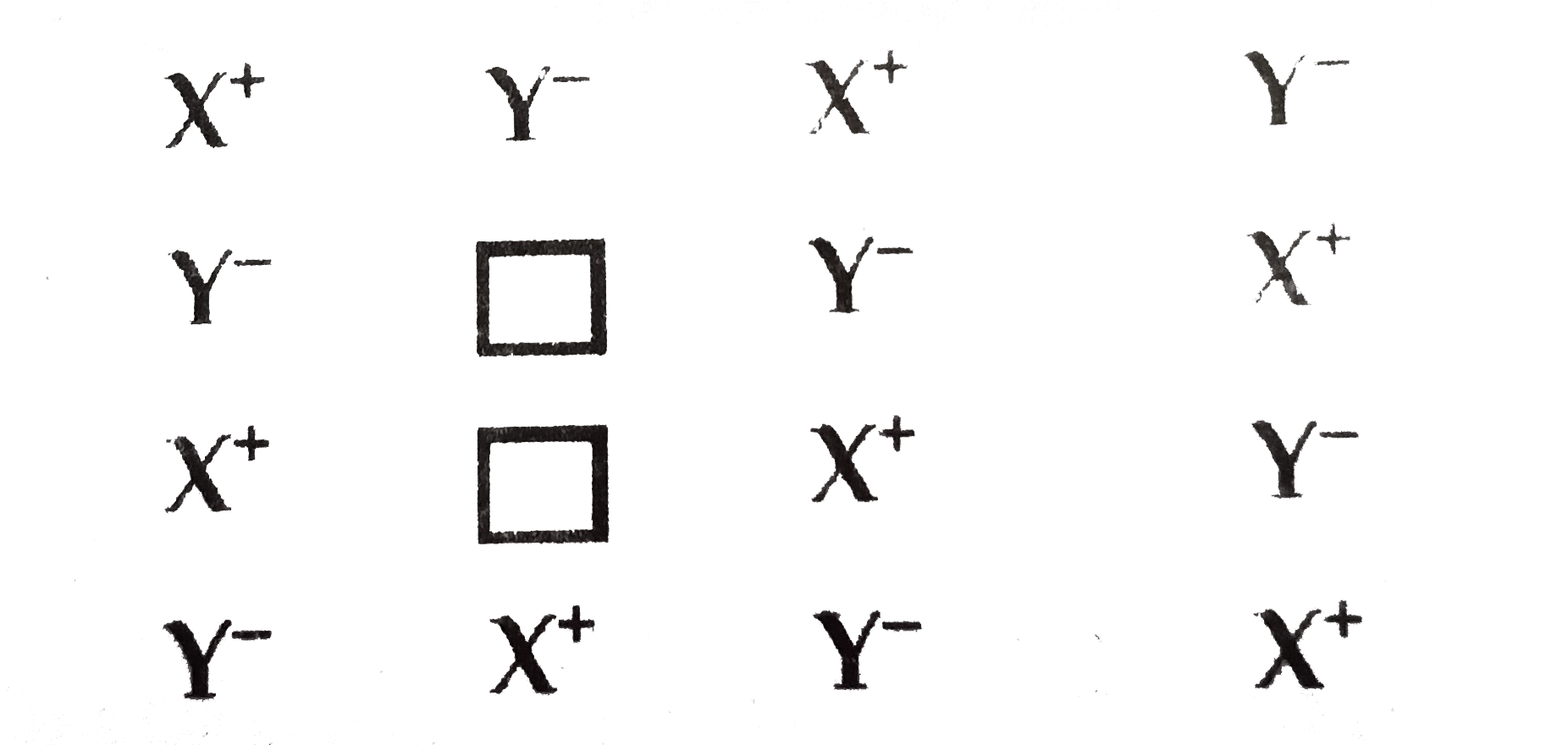Defects are basically irregularities in the arrangement of constituent particles. Broadly speaking the defects are of two types. Namely point defects and line defects.
Point defects: The irregularities or deviations from ideal arrangement around a point or an atom in the crystalline substance.
Line defects: The irregularities or deviations from ideal arrangement in entire row of lattice points.
Answer the following question.
When crystals of LiCI is heated in an atmosphere of Li (vap). it appears pink in colour because of
Metal excess defect due to anionic vaccanies.
Metal excess defect due to presence of extra cation at interstial site.
Metal deficiency defect.
Schottky defect.
To answer the question regarding why crystals of LiCl appear pink when heated in an atmosphere of Li (vap), we can break down the explanation into several steps:
1. Understanding the Context:
- LiCl is an ionic compound consisting of lithium ions (Li⁺) and chloride ions (Cl⁻). When heated in the presence of lithium vapor, we need to analyze the changes occurring in the crystal structure.
Hint: Identify the components of LiCl and their roles in the crystal structure.
2. Heating LiCl in Li Vapor:
- When LiCl crystals are heated in an atmosphere of Li vapor, the lithium atoms in the vapor phase interact with the LiCl crystal.
Hint: Consider what happens to the ions in the crystal when exposed to lithium vapor.
3. Migration of Chloride Ions:
- The lithium vapor causes some chloride ions (Cl⁻) to migrate away from the surface of the LiCl crystal. This creates vacancies where the Cl⁻ ions were originally located.
Hint: Think about the concept of vacancies in a crystal lattice and how they can be formed.
4. Formation of Electrons:
- As the lithium from the vapor interacts with the crystal, it can ionize to form lithium ions (Li⁺) and release electrons. These electrons can occupy the vacancies left by the missing Cl⁻ ions.
Hint: Relate the process of ionization to the creation of vacancies and electron presence.
5. Resulting Color Change:
- The presence of these electrons in the vacancies leads to a phenomenon known as color centers. Specifically, the absence of Cl⁻ ions (anionic vacancies) and the presence of electrons gives rise to the pink color in the crystal.
Hint: Consider how color centers are formed and their relation to the color observed in the crystal.
6. Type of Defect:
- The defect created in the crystal structure due to the migration of Cl⁻ ions and the presence of excess Li⁺ ions is classified as a "metal excess defect" due to the anionic vacancies created.
Hint: Identify the type of defect based on the movement of ions and the resulting electron presence.
Final Answer:
When crystals of LiCl are heated in an atmosphere of Li (vap), they appear pink in color due to the formation of anionic vacancies created by the migration of Cl⁻ ions, which are then occupied by electrons. This results in a metal excess defect.
- LiCl is an ionic compound consisting of lithium ions (Li⁺) and chloride ions (Cl⁻). When heated in the presence of lithium vapor, we need to analyze the changes occurring in the crystal structure.
- When LiCl crystals are heated in an atmosphere of Li vapor, the lithium atoms in the vapor phase interact with the LiCl crystal.
- The lithium vapor causes some chloride ions (Cl⁻) to migrate away from the surface of the LiCl crystal. This creates vacancies where the Cl⁻ ions were originally located.
- As the lithium from the vapor interacts with the crystal, it can ionize to form lithium ions (Li⁺) and release electrons. These electrons can occupy the vacancies left by the missing Cl⁻ ions.
- The presence of these electrons in the vacancies leads to a phenomenon known as color centers. Specifically, the absence of Cl⁻ ions (anionic vacancies) and the presence of electrons gives rise to the pink color in the crystal.
- The defect created in the crystal structure due to the migration of Cl⁻ ions and the presence of excess Li⁺ ions is classified as a "metal excess defect" due to the anionic vacancies created.
When crystals of LiCl are heated in an atmosphere of Li (vap), they appear pink in color due to the formation of anionic vacancies created by the migration of Cl⁻ ions, which are then occupied by electrons. This results in a metal excess defect.
Topper's Solved these Questions
- TEST PAPERSBOOK - ALLENCHAPTER - TEST PAPERSEXERCISE - CHEMISTRY
25 Videos
- TEST PAPERSBOOK - ALLENCHAPTER - TEST PAPERSEXERCISE - MATHEMATICS
2 Videos
- TEST PAPERSBOOK - ALLENCHAPTER - TEST PAPERSEXERCISE - part-2 Chemisty
18 Videos
- TEST PAPER 4BOOK - ALLENCHAPTER - TEST PAPER 4EXERCISE - CHEMISTRY
45 Videos
- THERMODYNAMICS BOOK - ALLENCHAPTER - THERMODYNAMICS EXERCISE - EXERCISE -4
18 Videos
Similar Questions
Defects are basically irregularities in the arrangement of constituent particles. Broadly speaking the defects are of two types. Namely point defects and line defects.
Point defects: The irregularities or deviations from ideal arrangement around a point or an atom in the crystalline substance.
Line defects : The irregularities or deviations from ideal arrangement in enitre row of lattice points.
Answer the following questions.
Select the correct statements :
(i) Frenkel defect create a vacancy defect at its original site and an interstitial defect at its new position.
(ii) Frenkel defect is stoichiometric point defect.
(iii) Frenkel defect is alos called dislocation defect.
(iv) Silver halide shows Frenkel defect.
View SolutionPoint defects are present in
View Solution
Knowledge Check
Examine the given defected crystal

Answer the following questions:
What type of ionic substance show such defect?ASchottky defect, decreases, NaCl and KCl etcBFrenkel defect, increases, As and Si etcCSchottky defect, increases, As and Bi etcDFrenkel defect, decreases, NaCl, KCl etcExamine the given defected crystal

Answer the following questions:
How is the density of crystal affected by this defect?ASchottky defect, decreases, NaCl and KCl etcBFrenkel defect, increases, As and Si etcCSchottky defect, increases, As and Bi etcDFrenkel defect, decreases, NaCl, KCl etc
What is point defects. Describe two types of point defects.
View SolutionThe crystal with metal deficiency defect is:
View SolutionWhich of the following defects is present in KCl crystals ?
View SolutionName some other defects of eye.
View SolutionDiscuss briefly the point defects in ionic crystals.
View SolutionName the defect in the following crystal:

View Solution
